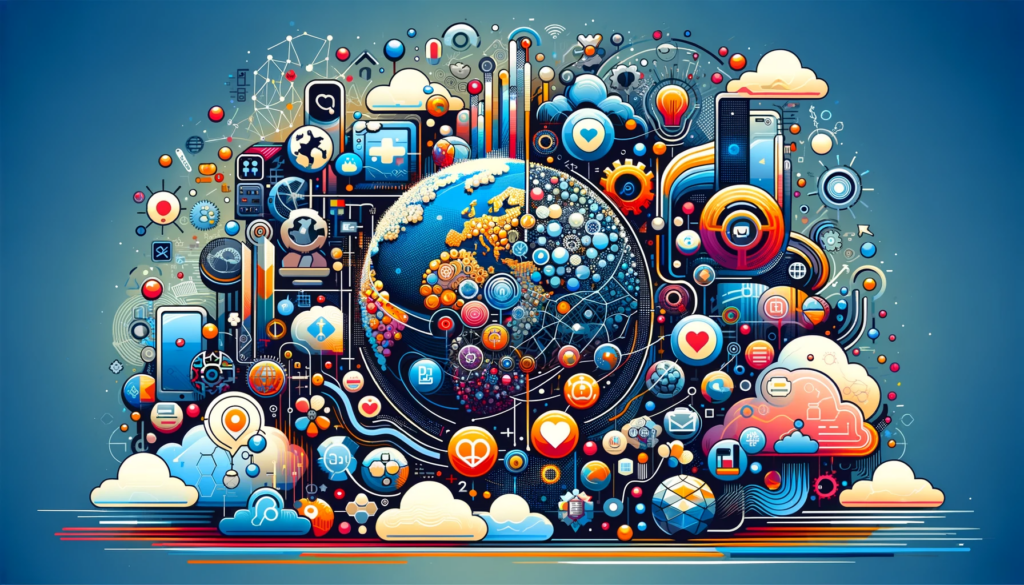Have you ever stopped to think about how software is literally eating the world?
It’s been over a decade since the dot-com bubble of the 90s, and the landscape has dramatically shifted.
We’ve seen giants like Facebook and Twitter stir the pot in Silicon Valley, sparking debates about their rapidly growing valuations and even leading to some eye-catching IPOs.
But you see, it also has a lot to do with recognizing the intrinsic value and potential of software.
Consider Apple, for instance. Despite its massive profitability and market dominance (it recently surpassed Exxon Mobil as America’s biggest company by market capitalization), its P/E ratio hovers around 15.2, aligning with the broader stock market. That’s something to chew on, especially when you realize that a genuine bubble can’t exist amidst constant bubble talk!
But here’s the real kicker: software is taking over far more than just our social networks and smartphones. It’s becoming the backbone of major businesses and industries.
So, buckle up! We’re about to explore just how deep this rabbit hole goes, diving into case studies and stats that’ll blow your mind.

What Is the Current Situation?
So, where do we stand now in this software-dominated scenario?
Well, it’s like we’re in the middle of a tech fairy tale that’s finally come true. We’re witnessing the culmination of decades of digital evolution – from the dawn of computing to the rise of the Internet – now, all the pieces are in place.
Let’s throw some numbers into the mix.
Here’s where it gets even juicier: the cost of running a basic Internet application has plummeted. Remember when it was about $150,000 a month back in 2000? Now, you can do the same for roughly $1,500 a month on Amazon’s cloud. This cost efficiency, coupled with a global online market, is what’s fueling a digitally wired global economy – a dream that was just a glimmer in the eyes of the early 90s geeks.
Take Amazon, for example. It started as an online bookstore and now? It’s the world’s largest seller and a software juggernaut, with no physical stores necessary. Even traditional industries like music and movies are getting a software makeover.
The biggest music companies now are the likes of iTunes, Spotify, and Pandora. And the top dog in video services? Netflix, a software company that’s left traditional providers scrambling to adapt.
Software in Medicine
Remember the last time you visited a doctor or a hospital? The healthcare industry is undergoing a massive change, thanks to software.
Electronic health records (EHRs)? That’s software at work. Telemedicine? Again, software.
For instance, a report from Grand View Research showed that the telemedicine market size was valued at USD 41.4 billion in 2019 and is expected to grow at a compound annual growth rate (CAGR) of 15.1% until 2027. That’s huge.
And it’s not just convenience. Software is enabling better patient care. Using a sea of data, AI algorithms can now predict patient risks and outcomes with stunning accuracy.
A sterling example of a company excelling in this area is Epic Systems. They’ve been a major player in the EHR market, providing software that supports medical record-keeping, referral coordination, and population health.
The Financial Sector’s Digital Makeover
Let’s talk money, shall we? The finance domain has been completely turned on its head by software. Fintech startups are popping up everywhere, challenging traditional banks.
Take mobile payments, for example. Statista reports that the total transaction value in the mobile POS Payments segment is projected to reach USD 2,735,741 million by the end of 2024. Mind-blowing, isn’t it?
And it’s not just about paying with your phone. Software is enabling personalized banking experiences, algorithm-driven investment advice, and so much more. ‘’
Software in Retail
Software in retail aims to make your shopping experience smooth and personalized. E-commerce giants like Amazon are just the tip of the iceberg.
The global international e-commerce market is expected to reach $1,910.5 billion by 2030, growing at a CAGR of 14.30% during 2021-2030. That’s a lot of shopping, and it’s all powered by software – from recommendation engines to inventory management systems.
But it’s not just about buying stuff online.
Retailers are using software to enhance in-store experiences too. Ever walked into a store and found an item you were just eyeing online? That’s software, making sure your shopping experience is seamless, whether you’re on your phone or in a physical store.

Software-Driven Manufacturing
Software is enabling manufacturers to design products with intricate precision using 3D modeling. This also allows streamlining of production lines, and optimization of supply chains for unprecedented efficiency.
Predictive maintenance, powered by software, is also making waves. Deloitte reports that it can slash maintenance costs by up to 40%. How? By using sensors and AI, manufacturers can predict equipment failures before they happen, reducing downtime and saving costs.
A good example here is Siemens, which uses its MindSphere platform to connect and analyze data from its machines. This approach not only improves efficiency but also enhances product quality. For instance, Siemens’ digital twin technology allows for virtual simulation and testing of products, cutting development time and costs significantly.
The Future of Work with Software
The rise of remote work, accelerated by global events like COVID-19, has catapulted software from a supporting role to the lead actor in our professional lives.
Take Zoom, for instance. This video conferencing tool has exploded in the past few years. Its revenue shot up by a staggering 326% in 2020, a testament to how integral software has become for work communication. But it’s not just about video calls. Project management tools like Asana and Trello have also changed how teams collaborate, breaking geographical barriers and enabling seamless workflows.
Moreover, the impact of software on work extends beyond just communication. Cloud-based platforms like Microsoft 365 and Google Workspace have become the new office space. They offer a suite of tools that mimic and enhance the physical office environment, allowing for document creation, real-time collaboration, and file sharing, all within a virtual space.
Software in Stores
Brick-and-mortar stores are also embracing software to improve the customer experience. For instance, Walmart uses data analytics and AI for inventory management and to personalize shopping experiences in-store, merging the digital and physical retail worlds seamlessly.
The numbers are telling: According to Shopify, by the end of 2024, 21.2% of total retail sales are projected to occur online.
Software in Education
The education sector is experiencing a digital revolution, thanks to software. With the advent of e-learning platforms, education has become more accessible than ever. Tools like Coursera and Khan Academy offer a plethora of courses to millions of learners worldwide, breaking geographical and financial barriers.
During recent times, schools and universities rapidly adopted software tools for remote learning. Platforms like Google Classroom and Zoom became essential, allowing educators to conduct classes and engage with students virtually. This shift is reflected in numbers too; the global e-learning market is expected to reach $325 Billion by 2025, as per a report by Global Market Insights.
Software in Transportation and Logistics
Software has become the backbone of the transportation and logistics industry, streamlining operations and enhancing efficiency. Companies like Uber and Lyft have disrupted traditional taxi services with their software-driven platforms, optimizing ride-hailing and sharing services with real-time data and algorithms.
In logistics, software is essential for managing complex supply chains. For instance, UPS uses sophisticated software for route optimization, saving millions of miles and gallons of fuel each year. MarketsandMarkets anticipates the TMS market size to grow from USD 13.5 billion in 2023 to USD 33.3 billion by 2028.
Wrap-Up
Excited about where software will take us next? I sure am. It’s a thrilling time to be in the tech world, and the possibilities are endless.
Here at Segwitz, we’re super into these changes and love making tech that fits right into this fast-paced world.
If you’re looking for more info on how to become tech forward to grow your business, you should totally check out our other blogs. We’ve got a bunch of cool insights on tech and development that you might find interesting.
Hope to catch you in our next blog.





 Booking System
Booking System eCommerce
eCommerce On-Demand Services
On-Demand Services Community App
Community App Ordering App
Ordering App Loyalty App
Loyalty App Online Learning
Online Learning Directory
Directory Marketplace
Marketplace SaaS
SaaS P2P Platform
P2P Platform eHailing
eHailing Healthcare
Healthcare Finance
Finance Logistics
Logistics Education
Education Food & Beverage
Food & Beverage Retail
Retail FMCG
FMCG Sports
Sports Travelling
Travelling Manufacturing
Manufacturing Renewable Energy
Renewable Energy Mobile Application Development
Mobile Application Development Web Application Development
Web Application Development Source Code Review
Source Code Review Internet of Things (IoT)
Internet of Things (IoT) Cyber Security
Cyber Security SegWitz SandBox – Dev-Team as Subscription
SegWitz SandBox – Dev-Team as Subscription SegWitz Streamline – SOP Systemization
SegWitz Streamline – SOP Systemization SegWitz ScaleUp – Tech Transformation of SME & PLC
SegWitz ScaleUp – Tech Transformation of SME & PLC SegWitz StartUp – MVP & Scaling
SegWitz StartUp – MVP & Scaling